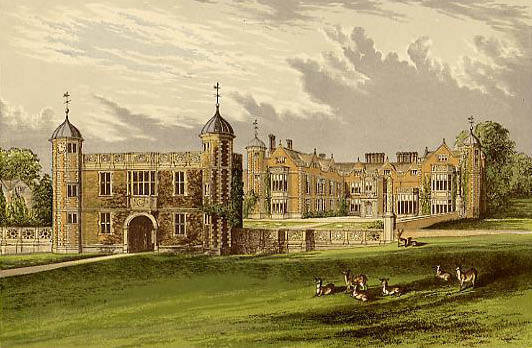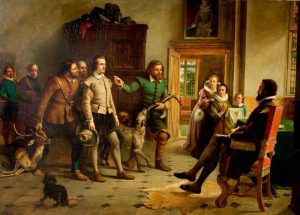Ananias Nason, a son of William Nason (1517/27-1573), was born in Charlecote, Warwickshire, England on July 10, 1551/52. His name is also spelled as Ananias Nasonne. Ananias moved his family to the Mickle Meadow Farm near the town of Stratford-Upon-Avon around 1580. He was a contemporary of William Shakespeare (1564-1616) a playwright and poet who lived in the same area. The 16th century began the shift from the medieval to modern era.

Ananias Nason had eight children with three wives. All his children were born on the Mickle Meadow Farm. His first wife was Ursula Rogers (born 1552). They married in 1570/71 in Stratford-Upon-Avon when they were both 19 or 20 years old. They had six children: Isabella Nason (? – April 25, 1606); Joan Nason (? – February 16, 1580/81); John Nason (March 23-31, 1582), Francis Nason (March 16, 1583-?), John (Johanius) Nason (September 3, 1585-November 12, 1624), and William Nason (January 8, 1588 -?). Our ancestor is John (Johanius) Nason who was born on September 3, 1585. Ursula Rogers died on April 16, 1588, and was buried the next day. She was around 36 years old. I wonder if she died from complications from childbirth?
Nason’s second wife was Ann E. Holmes (? – July 23, 1605). They married on August 11, 1589, at Stratford-Upon-Avon. She gave birth to one child, Annian Nason. Holmes was a stepmother to his 3-4 children from his marriage to Ursula Rogers. She raised them, since they were small children or toddlers at the time of the marriage and in their twenties or teens when she passed away in 1605.
Ananias Nason married for a third time five months after Ann Holmes’ death. Johanna Heath (? – January 30, 1624) and Ananias Nason married on December 12, 1605, in Stratford-Upon-Avon. One child, Willyum Nason, was born in 1607. Ananias Nason was 55 or 56 years old when his youngest child was born.
Ananias Nason was a tenant farmer on the lands of Sir Thomas Lucy (1532-1600), a loyal supporter of Queen Elizabeth I. The Queen visited Lucy at his Charlecote Park manor in 1572. Ananias may have seen the queen and her entourage during the visit.
In January 1584, Sir Thomas Lucy was one of the arbitrators in a dispute between Ananius Nason and William Shakespeare’s friend, Hamnet Sadler. “Outlines of the Life of Shakespeare, Vol 2 by James Orchard-Halliwell Phillips, 1884, describes the conclusion: “Paid for a pottle of secke, a pottle of claret wyne, and a half a pound of sugar, for Sir Thomas Lucy and Sir Foulke Grevile, Knyghtes, at the endinge the accion between Hamlett Sadler and Ananias Nason.” Lucy and Grevile granted them a bottle of wine “when they were friends.”
William Shakespeare had several connections to Sir Thomas Lucy. Lucy arrested a relative of Shakespeare’s mother, Edward Arden, for allegedly plotting against Queen Elizabeth. Arden was hanged, drawn, and quartered; his head was displayed by a city gate. Lucy harried the area’s Catholics after missionary activities by the Jesuit martyr, Edmund Campion, were revealed. Shakespeare may have modeled some of his characters in The Merry Wives of Windsor and The Tempest on members of the Lucy family. There is also a legend that William Shakespeare had to flee Stratford-Upon-Avon because he was caught poaching deer on Sir Thomas Lucy’s estate at Charlecote. Once he was in London, his writing career took off. After he became famous, he returned to Stratford-Upon-Avon. It tickles me to think that the deer poaching incident occurred on the edge of the property where our ancestors lived, Mickle Meadow Farm.

Ananias Nason died in Stratford-Upon-Avon on December 3, 1631. He was 79 or 80 years old. He outlived three wives and most, and perhaps, all of his children. One online family history mentioned that he died in an almshouse, a local charity set up for the elderly, primarily widows. Nason must have been tough and resilient, traits he passed along to his grandson and our ancestor, Richard Nason, who was about 90 years old when he died in South Berwick, Maine in 1693.
Ananias Nason lived during a time when the medieval gave way to the modern world. He was born during the golden age of Queen Elizabeth I and survived the plagues of 1564, 1593, 1603, and 1625. Religious ferment and persecution accelerated after the Gunpowder Plot by Guy Fawkes and other Catholic conspirators in 1605. Nason died during the reign of Charles I, a king whose quarrels with Parliament and all the accompanying political and social unrest would lead to an English civil war. Richard Nason’s father-in-law, Lieutenant John Baker, one of Oliver Cromwell’s Horse Guards, was to play a role in that conflict.

Thanks for a very complete telling of my ancestors story.
Robert, thank you for writing. I’m glad you enjoyed the post. I love the connection to Shakespeare.
H, Karen. I, too, have NASON families (in my Mom’s Harding family), and since I had decided to do a full family tree, I was thrilled to find all this information online about the much older part of our NASON families. I wish my mother were still here so she could have enjoyed reading everything I have regarding them now. Because I’m the oldest in my family (87), I felt it important to gather all this great information so I could share it with the rest of my family. I have such wonderful memories of visiting aunts, uncles, and cousins in Maine and becoming more aware of who was who. .. and the NASON name was a huge part of that. June Young
Hi, June!
I am so thankful for your wonderful note. I’m glad you enjoyed the post. I have been busy working on my mom’s family tree on Ancestry.com so I haven’t written as much as I would like about the Nasons and other English ancestors. I’m 73, and eager to chronicle as much family history that I can. However, I love researching and writing stories, since it brings the person to life so much more than just dates. Thank you again for your kind words. They made my day.
Karen